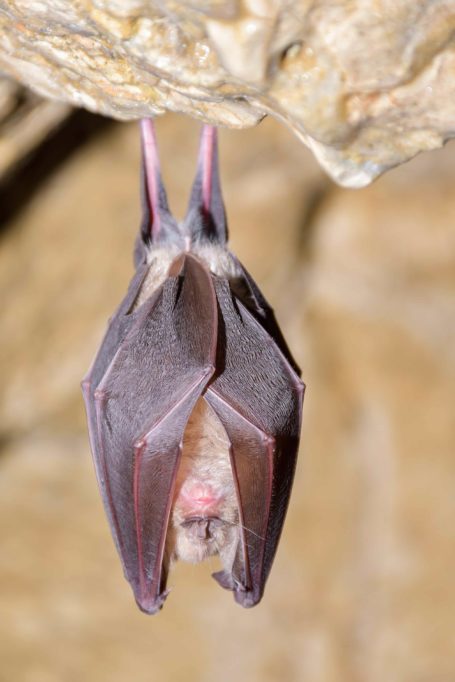Greater Horseshoe Bat (Rhinolophus ferrumequinum)
| Family | Horseshoe bats (Rhinolophidae) |
| Wingspan | 34-40 cm |
| Weight | 17-28 g |
| Appearance | grey-brown dorsal fur, grey-yellowish to white belly |
| Summer | roosts in buildings |
| Winter | Hibernates in caves or tunnels |
| Conservation status | Red List Luxembourg: Category 1 – Critically endangered (CR) |

The Greater Horseshoe Bat is a large bat with conspicuous horseshoe-shaped skin flaps around the nose. These are typical of the species and are used for directional ultrasound emission. As an agile flyer that often flies very low above the ground, the Greater Horseshoe Bat uses structures such as hedges and trees for orientation when hunting in open country. It prefers beetles and moths as food, which are also often caught from a perch. To do this, the bat hangs on a branch and waits for insects to fly by. The habitat of the Greater Horseshoe Bat consists of a habitat mosaic of deciduous forest, pastures, hedges, tree rows and orchards. This warmth-loving bat species has its European distribution centre in the Mediterranean region. It is very rare in Luxembourg and only one weekly roost, where the females give birth to their young, is known. In Central Europe, the maternity roosts are usually located in attics, which offer the animals enough space to stay in different temperature zones. The birth and rearing of the young, one per female, takes place from the end of June to the end of July. The males do not live together with the females at this time, but have their own quarters, which do not house such a large number of animals as the colonies of the females. In winter, the animals migrate to hibernation quarters, which are usually close to the summer quarters. To hibernate, they need frost-free tunnels or caves with high humidity. This prevents the sensitive flight skins from drying out during hibernation.
The species has become very rare due to the loss of rich insect populations as well as suitable roosting opportunities. Increasing road traffic also poses a threat to the bats.


